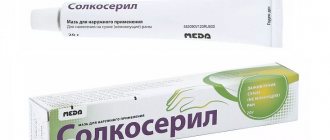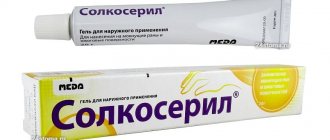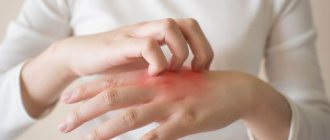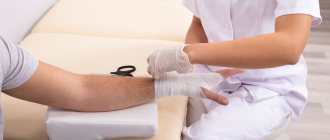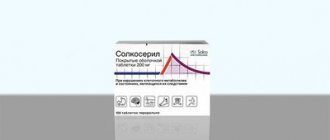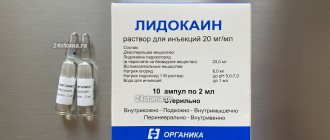Compound
The composition of 1 ml of solution for injection includes 42.5 mg of the active substance solcoseryl (deproteinized dialysate from the blood of dairy calves) and water for injection as an auxiliary component.
1 g of eye gel contains 8.3 g of the active substance solcoseryl (deproteinized dialysate from the blood of dairy calves) and auxiliary ingredients: sodium carboxymethylcellulose, sorbitol, water for injection, benzalkonium chloride.
1 g of Solcoseryl ointment contains 2.07 mg of the active substance solcoseryl (deproteinized dialysate from the blood of dairy calves) and a number of auxiliary components: methyl parahydroxybenzoate, propyl parahydroxybenzoate, cetyl alcohol, cholesterol, white petrolatum, water for injection.
pharmachologic effect
Solcoseryl is a medicine that affects mainly metabolic processes in tissues. They activate tissue metabolic processes, improve trophism and stimulate tissue repair and regeneration when exposed to damaging factors.
Solcoseryl in injection form belongs to the pharmacotherapeutic group of hemodialysates and hemofiltrates, ointment and jelly - to the category of drugs used to treat wounds and ulcers (including poorly healing ones), gel - to the category of drugs used to treat ophthalmological diseases.
Possible side effects and contraindications
Very rarely, urticaria, itching, redness, and marginal dermatitis appear at the site of application of solcoseryl. If such allergic reactions occur, it is recommended to stop using the ointment and consult a doctor to change the drug.
Solcoseryl is contraindicated in case of hypersensitivity to the components of the ointment. It is also recommended to use it with caution in patients prone to allergies.
Solcoseryl in cosmetology: effective fight against wrinkles
Women appreciated the effect of the drug on the condition of the skin, although the instructions do not contain instructions for using solcoseryl for the face. Based on it, recipes for many masks have been created that effectively even out skin tone, promote the healing of microtraumas, and solcoseryl also helps get rid of wrinkles.
Cosmetologists explain the effectiveness of solcoseryl as a cosmetic product by the pharmacological action of the drug. Stimulating metabolism in cells, collagen synthesis and activating tissue repair make it possible to use solcoseryl to combat wrinkles.
However, there are no studies that would confirm its effectiveness, which does not prevent the drug from being used in beauty salons and at home as part of a variety of face masks. Women consider the safety and low cost of procedures to be the indisputable advantage of cosmetics with the addition of solcoseryl.
Cosmetologists claim that solcoseryl ointment moisturizes and nourishes the skin, promotes the healing of small cracks and saturates cells with oxygen. The ointment is mixed with nourishing cream in a 1:1 ratio and the mixture is applied to the facial skin twice a week at night. Solcoseryl can be used undiluted as a face mask. The ointment is applied to the skin for 1.5 hours, after which it is washed off with warm water.
The ointment is especially effective as a lip balm. To do this, solcoseryl is mixed with your favorite balm and applied to the skin of the lips. This product helps to quickly restore damaged skin.
Pharmacodynamics and pharmacokinetics
The main component of Solcoseryl preparations are fractions of the blood of calves with natural low-molecular substances included in their composition, the molecular weight of which does not exceed 5000 daltons.
To date, its properties have only been partially studied. In vitro tests, as well as preclinical and clinical studies, have shown that calf blood extract:
- promotes the restoration and/or maintenance of aerobic metabolism and oxidative phosphorylation processes, and also ensures the replenishment of cells that do not receive sufficient nutrition with high-energy phosphates;
- in vitro enhances the utilization of oxygen and activates the transport of glucose into tissues and cells suffering from hypoxia and metabolically depleted;
- helps improve repair and regeneration processes in damaged tissues that do not receive sufficient nutrition;
- prevents the development or reduces the severity of secondary degradation and pathological changes in reversibly damaged cells and cellular systems;
- in in vitro models activates collagen synthesis;
- has a stimulating effect on the proliferation (reproduction) of cells and their migration (in in vitro models).
Thus, Solcoseryl protects tissues that are in a state of oxygen starvation and nutritional deficiency, and accelerates the processes of their restoration and healing.
Solcoseryl eye gel is a dosage form that was developed specifically for the treatment of damage to the stroma of the cornea.
The gel-like consistency of the product ensures its uniform distribution on the cornea, and good adhesive properties allow it to remain on it for a long period of time. The use of eye gel accelerates the restoration of damaged tissues and prevents scarring.
The rate and extent of absorption, distribution, as well as the rate and route of elimination of the active substance from the patient’s body cannot be determined using conventional pharmacokinetic methods, since protein-free calf blood extract has pharmacodynamic effects that are characteristic of molecules with different chemical and physical properties.
In the process of studying the pharmacokinetic characteristics of Solcoseryl solution in animals, it was found that after a bolus injection, the effect of the drug develops within half an hour. The effect lasts for three hours after administration of the solution.
Indications for use
Solcoseryl injections - what are they for and what groups of patients are they prescribed for?
Solcoseryl in ampoules is indicated for patients who have been diagnosed with occlusive peripheral artery disease of the third or fourth degree according to the Fontaine classification and who have contraindications or intolerance to other vasoactive drugs.
It is also prescribed to patients with chronic venous insufficiency , which is accompanied by the formation of treatment-resistant trophic ulcers , as well as to patients with disorders of cerebral metabolism.
What is Solcoseryl ointment and jelly for?
The use of ointment and jelly is advisable for the treatment of minor injuries (for example, abrasions or cuts), frostbite, first and second degree burns (thermal or solar), difficult-to-heal wounds (for example, trophic skin disorders of venous etiology or bedsores ).
Indications for use of eye gel
Solcoseryl eye gel is recommended:
- for the treatment of mechanical injuries and erosive damage to the cornea and conjunctiva;
- to accelerate the healing processes of postoperative scars in the postoperative period (for example, after a cornea transplant, surgery to remove a cloudy lens, surgical treatment of glaucoma , etc.);
- for the treatment of burns of the cornea of various origins (thermal, chemical or radiation);
- for the treatment of ulcerative lesions of the cornea and keratitis of various etiologies;
- for dystrophic lesions of the cornea of various etiologies, including neuroparalytic keratitis , endothelial-epithelial dystrophy ( bullous keratopathy ), etc.;
- for the treatment of corneal xerophthalmia with lagofatalmos (non-closure of the palpebral fissure);
- to improve the tolerability of contact lenses and reduce the time of adaptation to them.
Indications for use of Solcoseryl dragees
The drug in the form of pills is taken to treat trophic and radiation ulcers , bedsores , gangrene , and chronic venous insufficiency . They are also prescribed to patients with gastric and duodenal ulcers and to patients who require skin and/or corneal grafting procedures.
Indications
For each release form of Solcoseryl there are individual indications.
In the form of injections, the drug is prescribed when a patient is diagnosed with:
- occlusive peripheral artery disease grade 3 or 4;
- disturbances of venous blood flow with trophic lesions;
- strokes and traumatic brain injuries, which led to disruption of metabolic processes in the brain.
Ointment and gel for external use are used in complex treatment:
- minor abrasions and wounds;
- mild to moderate burns, frostbite;
- difficult-to-heal skin lesions: trophic ulcers, bedsores.
Ophthalmologists recommend the use of Solcoseryl eye gel to patients for the treatment of:
- injuries of the cornea and conjunctiva, their erosive lesions;
- scars after ophthalmological operations;
- eye burns of various types;
- dystrophic lesions of the cornea.
In addition, this gel is indicated for use in case of discomfort when wearing contact lenses and to reduce the time of getting used to them.
Contraindications
Administration of the solution is contraindicated in patients with known hypersensitivity to calf blood dialysates. The solution is also contraindicated for atopy and for persons allergic to milk.
Since the ointment, jelly and solution contain derivatives of parahydroxybenzoic acid , which are used as preservatives, as well as trace concentrations of benzoic acid in free form, it is not used in the presence of allergic reactions to the above substances.
Ointment and jelly should be prescribed with caution to persons with a predisposition to allergic reactions.
A contraindication to the use of eye gel is hypersensitivity to its components. Since the eye gel can cause temporary visual impairment, you should not drive a car or operate potentially dangerous machinery for half an hour after its use.
Reviews
Lera, 35 years old, Murmansk
Solcoseryl is a regular guest in the home medicine cabinet, because she has verified from her own experience that the ointment effectively eliminates the consequences of thermal burns. The skin recovers very quickly, and no characteristic redness or scars remain on the surface. I plan to use it for wrinkles. Can you share your experience?
Valentina, 43 years old, Stavropol
Lera, don’t even think about applying ointment to your face! Like you, I read a lot of reviews on websites and forums, and then thoroughly treated my nose, forehead, chin and cheeks - all problem areas. I did the mask at night. In the morning the skin was very oily, I had to force it and take a long time to wash it off. My skin dries out around the eyes and around the mouth. I used the ointment for 3 days. When I returned home from work on the 3rd day and took off my makeup, I was simply horrified - my skin had crusted over and became very dry. If you look from the outside, it may seem that you are sick with some serious illness.
Side effects
Administration of Solcoseryl IV or IM in very rare cases (their frequency does not exceed 0.1%) provokes the development of allergic or anaphylactic reactions, which are most likely caused by class E immunoglobulins.
If body temperature rises, urticaria , swelling and hyperemia at the site of drug administration, the use of Solcoseryl is stopped, and symptomatic treatment will be prescribed to eliminate the symptoms that appear.
Since the solution contains potassium, its administration may cause pain at the injection site.
When using Solcoseryl cream, a short-term burning sensation may be felt at the site of application. Discontinuation of the drug is required only in cases where the unpleasant sensation does not disappear for a long period of time.
In isolated cases, the use of jelly and ointment can cause the development of allergic reactions. If allergy symptoms appear, the use of these products should be discontinued.
Toxicological studies of Solcoseryl eye gel have shown the high safety of this drug when used for its intended purpose in accordance with the instructions.
After instillation of the product, a short-term burning sensation and mild irritation may be observed, which are not reasons for stopping treatment. Repeated instillations in rare cases provoke the development of allergic reactions (a similar effect is also observed during treatment with other ophthalmic drugs for topical use).
Side effects
The use of an injection solution in rare cases can lead to the development of allergic reactions, including anaphylactic shock. In this situation, you should immediately stop using the drug and prescribe symptomatic therapy in the form of antihistamines.
In addition, the process of performing the injection itself can be painful for the patient due to the potassium it contains.
When using the ointment, some patients may experience a burning sensation at the site of application.
Solcoseryl eye gel may cause short-term irritation, which is not an indication to discontinue treatment. The development of allergic reactions when using external forms of the drug is extremely rare.
Instructions for use of Solcoseryl (Method and dosage)
Solution for injection, instructions for use
In cases where the patient's condition allows, the drug is recommended to be used in the form of an injection solution diluted at least 50:50 with saline or glucose solution.
Solcoseryl in ampoules is intended for slow administration in the form of intravenous injections or infusions. If intravenous administration is not possible, the drug can be injected into the muscle.
Since the drug in its pure form is a hypertonic solution, it should be administered slowly.
For intravenous infusion, the drug should be pre-diluted with 0.25 l of 0.9% NaCl solution or 5% glucose solution. Solcoseryl solution is administered intravenously by drip. The rate of administration depends on the hemodynamic status of the patient.
Patients with occlusive disease of peripheral arteries of the third or fourth degree according to the Fontaine classification are shown daily injection into a vein of 0.85 g (or 20 ml of undiluted solution) Solcoseryl.
The duration of use is usually up to four weeks and depends on the clinical situation.
Patients with chronic venous insufficiency , which is accompanied by the formation of treatment-resistant trophic ulcers , are indicated for intravenous administration of 0.425 g (or 10 ml of undiluted solution) Solcoseryl three times a week.
The duration of the course of treatment should not exceed four weeks (it is determined depending on the nature of the disease).
To prevent the appearance of peripheral venous edema , therapy is supplemented by applying a pressure bandage using an elastic bandage. If the patient has skin trophic disorders, treatment is carried out by combining injections or infusions of Solcoseryl solution with the use of jelly, and then ointment.
Patients who have suffered ischemic or hemorrhagic stroke are prescribed daily intravenous administration of 0.425 or 0.85 g of Solcoseryl (10 or 20 ml of undiluted solution) as the main course. The duration of the main course is 10 days.
Further treatment involves daily administration of 85 mg (or 2 ml of undiluted solution) Solcoseryl for one month.
In severe forms of brain contusions, daily injection of 1000 mg of Solcoseryl into a vein (corresponding to 23-24 ml of undiluted solution) is prescribed for 5 days.
The drug is administered intramuscularly undiluted at a dose of 2 ml/day.
Solcoseryl jelly and ointment: instructions for use
Cream and ointment are intended for application directly to the wound surface. Before using these dosage forms, the wound is first cleaned using a disinfectant solution.
Patients with trophic ulcers , as well as in cases of purulent infection of wounds, require preliminary surgical treatment before starting treatment.
When using jelly and ointment for frostbite , as well as for treating ulcers and skin injuries, it is important to remember that only sterile dressings should be used to treat damaged areas.
The gel is intended for application to fresh (including wet) wounds and weeping ulcers. The product is applied in a thin layer to a previously cleaned wound surface two or three times a day.
To treat areas where epithelization has begun, the use of ointment is indicated. The use of jelly is advisable until pronounced granulation tissue begins to form on the damaged surface of the skin and the wound begins to dry out.
The ointment is used primarily to treat dry wounds. The product is applied in a thin layer to a previously cleaned wound surface once or twice a day. If necessary, cover the treated surface with a bandage.
The course of treatment with the drug in this dosage form continues until the wound heals and is completely healed with elastic tissue.
For patients with severe trophic damage to the skin and soft tissues, it is recommended to combine jelly and ointment with the injection form of Solcoseryl.
Experience with the use of jelly and ointment for children is limited.
The drug does not have such release forms as suppositories. However, in the complex therapy of chronic colitis (inflammation of the colon), microenemas with Solcoseryl jelly are often prescribed.
Before use, the jelly contained in the tube (all 20 g) is added to 30 ml of warm water and after the enema procedure, which is carried out to cleanse the intestines, it is administered daily for 10 days.
Solcoseryl eye gel, instructions for use
Unless otherwise instructed by the attending physician, the eye gel is instilled into the conjunctival cavity, one drop three or four times a day. It is recommended to use the product daily until complete recovery.
In particularly difficult cases, eye ointment can be used one drop per hour. If the patient is simultaneously prescribed eye drops and Solcoseryl eye gel, the gel should be applied approximately half an hour after the drops.
During the period of adaptation to contact lenses, the drug is instilled into the conjunctival cavity immediately before installing the lenses and immediately after removing them.
Dragee Solcoseryl: instructions for use
The instructions recommend taking 100 mg tablets three times a day.
Solcoseryl gel for external use 10% 20g
Compound
Composition per 1 g:
Active component:
Solcoseryl (deproteinized dialysate from the blood of dairy calves), in terms of dry matter 4.15 mg/g.
Excipients:
Solcoseryl gel - methyl parahydroxybenzoate, propyl parahydroxybenzoate, sodium carmellose, propylene glycol, calcium lactate pentahydrate, water for injection.
Indications for use
Solcoseryl gel/ointment is used in the following cases:
1. minor damage (abrasions, scratches, cuts)
2. 1st and 2nd degree burns (sunburn, thermal burns)
3. frostbite
4. difficult-to-heal wounds (including trophic ulcers and bedsores).
For the treatment of trophic lesions of tissues of various origins, Solcoseryl is used only after removal of necrotic tissue from the wound.
Solcoseryl gel is used in the initial stage of treatment and is applied to fresh wounds, wounds with wet discharge and ulcers with weeping phenomena. Solcoseryl ointment is used primarily for the treatment of dry (non-wetting) wounds.
Contraindications
There is no information on the effects of an overdose of Solcoseryl gel/ointment.
Directions for use and doses
Solcoseryl is used topically, applied directly to the wound surface after preliminary cleansing of the wound using a disinfectant solution.
Before starting treatment of trophic ulcers, as well as in cases of purulent infection of the wound, preliminary surgical treatment is necessary,
Solcoseryl gel
applied to fresh wounds, wounds with wet discharge, and ulcers with signs of weeping in a thin layer on a cleaned wound 2-3 times a day. It is recommended to lubricate areas where epithelization has begun with Solcoseryl ointment. The use of Solcoseryl gel is continued until pronounced granulation tissue forms on the damaged skin surface and the wound dries out.
Solcoseryl ointment
Apply a thin layer to a cleaned wound 1-2 times a day. Solcoseryl ointment can be used under bandages. The course of treatment with Solcoseryl ointment continues until the wound is completely healed, its epithelization and the formation of elastic scar tissue.
For the treatment of severe trophic damage to the skin and soft tissues, the simultaneous use of parenteral forms of Solcoseryl is recommended.
Storage conditions
At a temperature not higher than + 30 C.
Keep out of the reach of children.
Best before date
5 years from the date of production. Do not use after the expiration date stated on the package.
special instructions
Solcoseryl should not be applied to a contaminated wound, since it does not contain antimicrobial components,
The use of Solcoseryl, like all other medications, is undesirable during pregnancy and lactation and is possible only when absolutely necessary and under the supervision of a doctor,
If you experience pain, redness of the skin near the site where Solcoseryl was applied, secretion from the wound, or increased temperature, you should immediately consult a doctor.
If, when using Solcoseryl, healing of the affected area is not observed within 2-3 weeks, you should consult a doctor.
Description
Homogeneous, almost colorless, transparent gel of dense consistency. The characteristic light smell of Solcoseryl (the smell of meat broth).
Conditions for dispensing from pharmacies
Over the counter
Dosage form
gel for external use
Pharmacodynamics
Solcoseryl is a deproteinized hemodialysate containing a wide range of low molecular weight components of cell mass and blood serum of dairy calves with a molecular weight of 5000D (glycoproteins, nucleosides and nucleotides, oligopeptides, amino acids).
It has been established that SOLCOSERYL has the following properties:
— improves the transport of oxygen and glucose to cells under hypoxic conditions,
- increases the synthesis of intracellular ATP and promotes an increase in the proportion of aerobic glycolysis and oxidative phosphorylation,
- activates reparative and regenerative processes in tissues,
— stimulates the proliferation of fibroblasts and the synthesis of collagen in the vascular wall. Solcoseryl gel
does not contain fats as auxiliary components, making it easy to wash off. Promotes the formation of granulation tissue and the elimination of exudate.
From the moment fresh granulations appear and the wound dries, it is recommended to use Solcoseryl ointment,
containing fats as auxiliary components and forming a protective film on the wound surface.
Side effects
In rare cases, allergic reactions in the form of urticaria and marginal dermatitis may develop at the site of application of Solcoseryl. In this case, you must stop using the drug and consult a doctor.
A short-term burning sensation may be observed at the site of application of Solcoseryl gel. If the burning sensation does not go away for a long time, the use of Solcoseryl gel should be abandoned.
Interaction
The interaction of Solcoseryl with other topical medications has not been established.
Overdose
There is no information on the effects of an overdose of Solcoseryl gel/ointment.
special instructions
Studies regarding the safety of using Solcoseryl solution for the treatment of children have not been conducted, therefore the drug is not recommended for the treatment of children under the age of 18 years.
Experience in treating children with the use of eye gel and topical dosage forms of the drug is also limited.
Solcoseryl in ampoules should be administered separately from other drugs (it is especially incompatible with phytoextracts). The exceptions are isotonic 0.9% NaCl solution and 5% glucose solution. It is also not recommended to dilute the product in potassium-containing solutions for infusion.
Eye gels are characterized by the ability to stick to contact lenses, so it is recommended to stop wearing lenses during treatment with the drug.
If allergic reactions associated with the use of the drug occur, you should immediately report them to your doctor. If the drug is used to treat an infectious disease of the cornea, therapy is supplemented with the prescription of appropriate antimicrobial agents.
Avoid contact of the gel with soft contact lenses as it may discolor them.
If necessary, treatment with Solcoseryl can be supplemented with antibacterial, vasodilating and other drugs.
Solcoseryl in cosmetology: for the face, hands, rough elbows and heels, for the skin around the eyes
In medicine, Solcoseryl preparations are used to accelerate the healing of damaged skin; in home cosmetology, they are used as a remedy for acne, stretch marks, and wrinkles. They are used to soften the skin, increase its turgor, improve complexion and eliminate acne .
In cosmetology, the ointment can be used as a stand-alone product (it is applied pointwise to problem areas, in the form of a mask once a week before bedtime and two to three times a week on the skin around the eyes), or in combination with other products, in particular with the drug Dimexide . Let's look at how to use these medications together.
For the face, Dimexide and Solcoseryl are used as follows: on the face, neck and décolleté, previously cleaned with peeling agents (you can also do alkaline peeling using tar soap, salt and soda), apply a solution of Dimexide with water, prepared in a ratio of 1:10 (enough dilute 5 ml (teaspoon) of Dimexide in 50 ml of water); Before the product has time to be absorbed, Solcoseryl ointment is applied to it in a thick layer.
If the gel is used in cosmetology, then the mask should be periodically sprayed with thermal water (you can also use regular water through a spray bottle). The mask is left on the face for about half an hour to an hour, then washed off and a light hypoallergenic cream is applied to the skin.
According to women who have tried this mask recipe on themselves, Solcoseryl ointment is more comfortable for the face than gel (after application, you don’t have to wash it off, just remove the residue with a napkin). In addition, it is not recommended to use a gel mask more than once a month.
Used as a remedy for wrinkles around the eyes, Solcoseryl ointment has proven itself to be a very effective remedy. Applying it like a regular cream, within a week you can see that the number of wrinkles and wrinkles has decreased, the skin has tightened and smoothed, and its color has become fresher and healthier.
Dimexide and Solcoseryl are no less effective against wrinkles, and perhaps even more effective. This is due to the ability of Dimexide to enhance the penetration of the active substance of drugs deep into the tissue. After using these products in combination, skin irregularities and imperfections disappear, and the effect of the mask is comparable to the effect of Botox .
The gel and ointment can also be used to soften rough skin on the elbows and heels. It is best to apply them to problem areas before bed.
Mode of application
Solution
Solcoseryl in the form of a solution is recommended to be administered intravenously slowly in the form of an injection or by drip, having previously diluted it with saline solution or 5% glucose solution. If intravenous administration is difficult, intramuscular injection is allowed.
For the treatment of venous insufficiency, the drug is prescribed for up to a month, combining it with the application of an external gel or ointment to the area of trophic ulcers.
Patients who have suffered a stroke are prescribed a course of treatment with Solcoseryl for 5 weeks. When treating traumatic brain injuries, short courses lasting 5 days are prescribed.
Ointment and gel
Ointment and gel for external use are applied directly to the wound. Before using them, the wound surface is thoroughly disinfected. In the presence of purulent discharge, surgical treatment may be required.
The gel is used to treat wet, fresh wound surfaces. When the affected area begins to epithelialize, granulation tissue appears and the wound dries out, you should switch to using Solcoseryl in the form of an ointment.
The course of treatment with external forms of the drug is carried out until the wound surface is completely healed and a scar is formed.
Ophthalmic gel
The eye gel is instilled into the conjunctival cavity 3-4 times a day, one drop at a time. In some cases, it is possible to use the drug hourly. The course of treatment lasts until complete recovery.
Analogues of Solcoseryl
- Aekol
- Acerbin
- Bepanten
- Shostakovsky Balm
- Wundehill
- Depanthol
- Contractubex
- Pantekrem
- Pantexol Yadran
- Panthenol
- Pantestin
- Hepiderm Plus
- Echinacin Madaus
Reviews of Solcoseryl
Almost all reviews left on the forums about injections, eye gel, jelly and Solcoseryl ointment are positive. Rare negative reviews are due largely to the fact that the drug provoked allergic reactions associated with intolerance to its active component.
Reviews of Solcoseryl gel and the drug in the form of an ointment allow us to conclude that these drugs effectively cope not only with minor scratches and minor burns, but also help cure difficult-to-heal wounds and ulcers.
The effectiveness of the ointment in cosmetology is also highly appreciated. Reviews of Solcoseryl ointment for the face indicate that this is truly an indispensable product for those who want to quickly get rid of wrinkles, acne, and simply improve the color and tone of the skin.
Gel is no less effective against wrinkles, but cosmetologists believe that it should not be used as part of masks too often (optimally - once a month). The ointment can be used as a regular cream.
The effectiveness of Solcoseryl against wrinkles increases when combined with Dimexide , which is due to the latter’s ability to improve the penetration of the active substance deeper into the skin.
Instructions for use
In accordance with the instructions for use, solcoseryl ointment and gel are applied only externally in small quantities with an even distribution over the affected area. The gel composition is usually used immediately after injury to the skin, when exudate is released from the damaged capillaries. Ointment is a more effective remedy at the stage of wound epithelization (including for rapid healing of cracks).
Solcoseryl ointment is applied to the affected area in a thin layer 1 to 3 times a day. Instructions for use:
- The wound is carefully treated with an antiseptic.
- The drug is applied to the surface of the affected area.
- To treat a small area of skin, 1 to 2 g of medication is sufficient.
- The composition is evenly distributed over the affected area without further rubbing.
- The procedure is repeated 2 to 3 times a day.
In case of severe lesions, medicinal applications are allowed; if the problem is localized in the facial area, a mask is applied at night. The main advantage of the ointment is the uniform and prompt restoration of the integrity of the skin, without drying out the tissues. No scars are formed at the treatment site.
Indications and contraindications
Solcoseryl ointment and gel are prescribed for the treatment of wounds, restoration and rapid healing of affected areas, and prevention of necrosis. The drug is actively used in complex therapy for severe tissue pathologies.
Indications for prescribing the drug:
- superficial violation of the integrity of the epidermis;
- dry calluses;
- psoriasis;
- fissures in the anus, inflammation of hemorrhoids (in the treatment of hemorrhoids);
- post-acne;
- dermatitis;
- dryness or damage to the nasal mucosa;
- bedsores;
- ulcers.
In some cases, the therapeutic regimen is supplemented with solcoseryl gel (for diseases of the lungs, nasopharynx and throat).
Contraindications:
In accordance with the official data presented in the annotation for the medication, solksoeril does not cause allergic reactions. However, it is contraindicated for use in case of individual intolerance to any ingredient, as well as in case of hypersensitivity of the body to the components of the composition. It is important for pregnant women to consult a doctor first.
Directions for use and doses
Before using the medication, it is necessary to establish the etiology of the disease. Depending on the severity of the pathological process, the doctor prescribes solcoseryl gel or ointment, a suitable dosage and frequency of use of the medicine.
Recommended dosages and methods of applying the medication:
- Thermal skin lesions (grades 2 and 3) - a gel is prescribed at the initial stage. They treat the affected areas up to 3 times a day. The dosage is determined individually. The positive dynamics of therapy is indicated by the formation of a pink layer of skin on the problem area of the skin. At the epithelization stage, the ointment is applied once a day until the wound is completely healed.
- Diabetic foot - an area with a pathological process is treated up to 2 times a day. Duration of therapy is from 1 to 1.5 months.
- Bedsores and trophic ulcers - gel is applied to the pathogenic area, and ointment is applied to the edges. The procedure is carried out 2 times daily. The duration of treatment is 21 days.
- Sunburn - ointment and gel are applied up to 2 times a day. Treatment lasts up to 30 days.
- Scratches and shallow cuts - apply gel to a fresh wound 2 times a day. After epithelization - ointment. Therapy is continued until the integrity of the skin is completely restored.
In dentistry, dental solcoseryl is actively used in the form of a paste. It is used only as prescribed by a doctor. The medication has pronounced analgesic properties. After application to the surface of the mucous membrane or gums, it forms a thin film, which protects the surface from the penetration of potentially unsafe substances.
Side effects and special instructions
It is not recommended to use solcoseryl gel for the face, since it is characterized by an active and direct effect in the area of application. For cosmetic purposes, ointments are preferred because they provide a prolonged effect.
The drug in question does not cause side effects. In case of individual intolerance to the components of the composition, allergic reactions may occur in the form of burning, itching or redness. External manifestations disappear after 10-20 minutes and do not require treatment.
Special instructions:
- The drug is used with caution when using ACE inhibitors, diuretics, and potassium drugs.
- It is important to seek medical attention if side effects occur. The doctor should reconsider the therapeutic regimen.
- The shelf life of the medicine is up to 5 years in a sealed state.
Prescription and withdrawal of a pharmaceutical drug is carried out only by the attending physician. Self-medication can aggravate the course of the disease and cause associated complications.
Solcoseryl price, where to buy
The price of Solcoseryl gel 20 g in Russia is about 2,600 rubles.
The average price of Solcoseryl in ampoules of 5 ml No. 5 in Ukrainian pharmacies is about 500 hryvnia.
- Online pharmacies in RussiaRussia
- Online pharmacies in UkraineUkraine
- Online pharmacies in KazakhstanKazakhstan
LuxPharma* special offer
- Solcoseryl ointment tube 20g
RUB 2,170 order - Solcoseryl injections/solution for injection (Solcoseryl ampoules) 42.5 mg/ml 5 ml No. 5
RUR 4,780 order
Pharmacy Dialogue
- Solcoseryl gel (tube 20g)Legacy
RUB 2,633 order
show more
Pharmacy24
- Solcoseryl 5 ml No. 5 injection solution Legacy Pharmaceuticals, Sweetseland GmbH, Switzerland
515 UAH. order - Solcoseryl 4.15 mg/g 20 g gel Legacy Pharmaceuticals, Sweetseland GmbH, Switzerland
164 UAH order
- Solcoseryl 2.07 mg/g 20 g ointment Legacy Pharmaceuticals, Sweetseland GmbH, Switzerland
136 UAH order
- Solcoseryl 42.5 mg/ml 2 ml N25 injection solution Legacy Pharmaceuticals, Sweetsland GmbH, Switzerland
919 UAH. order
PaniPharmacy
- Solcoseryl ampoule Solcoseryl injection solution ampoules 2ml No. 25 Switzerland, Legacy Pharmaceuticals Switzerland
950 UAH order
- Solcoseryl gel Solcoseryl jelly 10% 20g Switzerland, Legacy Pharmaceuticals Switzerland
161 UAH order
- Solcoseryl injection solution ampoules 5 ml No. 5 Australia, Legacy Pharmaceuticals Sweetsland GmbH
476 UAH. order
- Solcoseryl ampoule Solcoseryl injection solution ampoules 5ml No. 5 Switzerland, Legacy Pharmaceuticals Switzerland
545 UAH. order
- Solcoseryl jelly 10% 20g Australia, Valeant Pharmaceuticals Sweetsland
181 UAH order
show more
